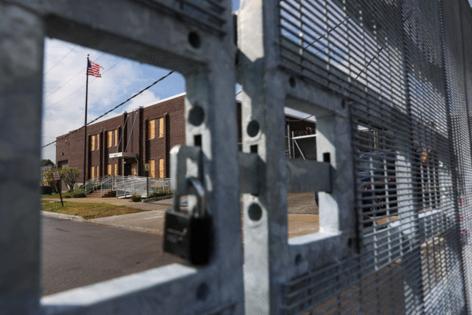Judge to rule this week whether ICE security fence in Chicago suburb must come down
Published in News & Features
CHICAGO — A federal judge said Tuesday she’ll rule within a day or two on whether a controversial security fence constructed around the U.S. Immigration and Customs Enforcement detention facility in Broadview is violating the west suburb's right to access its own land.
The village of Broadview is seeking a restraining order requiring the removal of the 8-foot-tall fence, which was constructed around the temporary holding facility on Beach Street that has seen daily protests and federal agents using tear gas and other weapons on crowds.
During arguments in the lawsuit Tuesday, U.S. District Judge LaShonda Hunt began by warning both sides she didn’t want to get caught up in the politics of the moment.
“It is very charged, it is very challenging,” Hunt said. “There are so many words we could use here, but it is volatile. But those issues are not before me.”
Attorneys for Broadview argue that the U.S. Department of Homeland Security, which includes ICE, constructed the fence “in the middle of the night without notice,” and that it not only physically deprives the village of its right to control its own land, but constitutes a public safety hazard by blocking emergency service personnel and vehicles from reaching several commercial and industrial properties located on the other side.
Lawyers for the government, meanwhile, said the village still has access to the area through a key-card gate on another street, and that complaints that the gate was too small for fire trucks did not hold water.
“Our understanding is that a Greyhound bus can fit through that gate,” said attorney Thomas Walsh of the U.S. attorney’s office’s civil litigation division.
Walsh said the government had “no other option” than to put up the fence because protesters were gathering day after day and accosting law enforcement outside the facility, inciting violence and slashing tires of ICE vehicles pulling in and out of a secure lot.
“This went on for weeks,” Walsh said. “If the fence comes down, it is very foreseeable that the same kind of violence is going to occur.”
Hunt pointed out the building had been there for 40 years without issue, yet no one seemed to have a plan for protesters once the Trump administration’s immigration push began.
“What was the plan that the federal government had with respect to protecting the people and the property there when they decided to launch this ‘Operation Midway Blitz?'” the judge asked.
She also said she found it “very problematic” that the federal government “subjecting the village to the same sort of restrictions as everybody else” that seems to be problematic here
Both sides, meanwhile, told the judge that settlement talks would be fruitless.
“We’ve had no formal discussions,” said Mark Albert, one of the attorneys for the village. “The only real communication we got was the letter from (ICE Chicago Field Office) Director (Russell) Hottthat specifically said we are part of the problem.”
Hunt said she’d rule within “the next day or so.”
“I think we need to have this resolved — obviously the situation is fluid,” she said.
The lawsuit was the latest in an ugly back-and-forth between Broadview and federal immigration officials that has heated up as Operation Midway Blitz has worn on.
On Sept. 26, Broadview Mayor Katrina Thompson sent a letter to DHS officials complaining not only about the fence but the “relentless deployment of tear gas, pepper spray, mace and rubber bullets” outside the facility that she said was harming not only protesters exercising their First Amendment rights but also Broadview police and firefighters working at the scene.
In response, ICE Acting Director Todd Lyons wrote that rioters were “laying siege and interfering with legitimate law enforcement operations” and that the agency had no intention to change its “operational posture.”
“You can either continue to be part of the problem or choose to be part of the solution by directing your police to enforce local ordinances and working with us to remove violent offenders,” Lyons wrote.
Last week, Illinois State Police and the Cook County Sheriff’s Office were called in to help quell unrest around the ICE building, and Broadview announced Monday that protests were to be limited to daytime hours to discourage violence.
And on Tuesday, despite the vehement objection of Illinois officials, members of the Texas National Guard began arriving in the Chicago area, part of a call-up ordered by President Donald Trump to help quell protests and protect immigration agents.
_____
©2025 Chicago Tribune. Visit chicagotribune.com. Distributed by Tribune Content Agency, LLC.







Comments